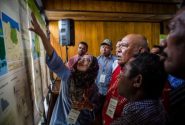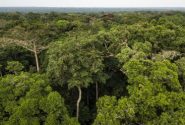
Soybean cultivation in Mato Grosso, Brazil. Instituto de Pesquisa Ambiental da Amazonia, Daniel Nepstad.
LIMA, Peru (27 August, 2012)_Conservation concerns have gained important ground in policy decision making in the Amazon region, but mainstream policy goals to stimulate food and energy supply still need to be more effectively harmonised with environmental policy, a CIFOR expert said ahead of the IUCN World Conservation Congress which begins next week.
Pablo Pacheco urged decision makers in Bolivia, Brazil, Colombia, Ecuador, Guyana, Peru, Suriname, French Guiana, and Venezuela — the nations that share the five million square kilometre forest — to more aggressively address issues causing tension between economic growth and forest conservation in the Amazon.
Issues dominating the development agenda in the Amazon include agricultural expansion (soybean crops and beef cattle), extraction of natural resources (timber, oil and gas and, most recently, minerals) and infrastructure development.
“These different issues have been identified in one way or another in the policy debate about development and conservation in the Amazon, and significant progress has been made in different sectors such as biodiversity conservation, forestry development or agricultural expansion. Nonetheless, these sectors still compete with each other and policies are not fully harmonised,” he said.
“This harmonisation can be improved through supporting policy innovations to tackle such problems and sharing lessons learned on what works for forests and the people.”
While agricultural expansion and the development of associated economic activities in the Amazon are justified by their contribution to state earnings and regional development, they have long-term social and environmental implications. Furthermore, large-scale investments often do not favour the wellbeing of local populations, and tend to negatively affect the integrity of the environment.
“It is not justifiable for agribusiness to place additional pressures on forests when there are more suitable lands for agriculture elsewhere. Some of these lands are degraded, but they may be restored and be suitable for more intensive uses needed to meet market demands,” Pacheco said.
Inequities in benefit sharing also need to be seriously addressed, said Pacheco, who heads CIFOR’s research on globalised trade and investment.
Enhancing land and forests management but acknowledging diversity
Land across the Amazon is still largely concentrated in the hands of a few and those that control the assets also have better access to markets. While, there have been efforts to distribute land to smallholders, and to support indigenous people and peasant communities to secure tenure to their land, little has been done to support these groups to obtain the benefits they may derive from agricultural and forest markets.
While in some cases smallholders have benefited from financial incentives like credit loans and technical assistance, it is still hard for them to compete in markets and to provide high quality products to a few retailer chains in the cities which are increasingly controlling the urban food markets.
Smallholders also need to find ways to manage forest resource use and crop expansion without compromising forests, which provide many ecosystem services that can benefit agricultural activities such as water regulation and crop pollination.

A family makes its way down a mud-filled road in Vila Da Canpas in the Amazon region of Brazil, near Manaus. Brazil. Julio Pantoja/World Bank
Due to growing environmental concerns policies have been put in place imposing constraints on land and forest use, regardless of the user, which in several cases tends to discriminate against smallholder and communities.
Brazil, for example, has stimulated individual landholders to protect forest reserves or to restore them if they exceed permitted amounts, though the specific rules are currently being revisited in the Brazilian Congress. Other countries, like Bolivia, have adopted relatively elaborated regulations to manage land use expansion in private owned lands, and Ecuador is taking some steps to follow the same direction.
“Imposing land use and forest management regulations in lands claimed by private landholders, either individuals or communities, is important since a larger portion of forests is slowly being transferred by the states to private hands,” Pacheco said.
“But it would make much more sense to devise more realistic regulations that better fit the needs and capacities of smallholders and communities versus large-scale landholders and industry.”
Why conservation activities need to be better aligned to broader tenure reforms
In spite of the process of formalising rights in favour of individual landholders and communities, including indigenous people, there are still valuable forests under the public domain, as well. But while one portion of those forests might be protected to a degree, another may be locked up in disputes with ranchers, loggers, landless people, urban residents, conservation groups and others.
It is not justifiable for agribusiness to place additional pressures on forests when there are more suitable lands for agriculture elsewhere.
For this reason, conservation policies need to be better aligned with land tenure policies, not only to reduce encroachment of public forestlands, often motivated by road development and market integration, but to protect customary rights of indigenous people and other local populations to use land and forest resources.
According to CIFOR research, governments across the region have gotten better at recognising the collective rights of local communities to land, but they are still exposed to growing commercial pressures, and have limited options to benefit in a meaningful way of such resources. In addition, titling processes are slow, bureaucratic and costly, and tend to be associated with land speculation.
Investing in securing public lands, granting legitimate local tenure rights, and solving tenure disputes should continue to be one of the top priorities, Pacheco said.
Improving incentives and ways to provide public services
Another priority is to continue investing in advancing decentralization. In spite of the efforts to bring more decision making to the regional and municipal level—such as in Bolivia, Peru and Ecuador— decision-making related to environmental policy often continues to occur at the central and departmental levels.
“It’s not yet entirely clear whether a centralized or decentralized government system works best for forests. However more decision-making at the local level and inclusion of local systems for land and forest management would be desirable”.
However, there have to be “improved incentives in place, such as compensations for conservation and enhanced mechanisms for provision of public services to help balance development and conservation goals”, says Pacheco.
Additionally, governments need to keep rethinking ways in which public institutions, or public-private partnerships, can be more effective in providing public services, conservation and economic incentives, and enforcing laws, he added.
Sharing innovations and accommodating multiple interests
The most impressive advances have been in land cover monitoring, especially in Brazil. Its government has put in place a system to update data on deforestation and this information has been used to inform policies and decisions at federal and state levels, and shared openly with broader society. Even more, efforts are in place supporting the transfer of such technology to other Amazon nations.
Bolivia also has a lot to contribute regarding implementation of land and forest tenure reforms, and what works and what does not for production and conservation. And Ecuador is expanding economic incentives for promoting conservation and forest regeneration, while also making important progress in improving the efficiency of the forest timber monitoring systems.
In this regard, each Amazonian country has its own set of environmental and development policy objectives that do not necessarily coincide with the interests of its neighbours. But there are important overlapping concerns, including the protection of forest in the face of climate change and finding ways to make sure forests can contribute to the livelihoods of communities that depend on them, as well as for the provision of services that benefit broader society.
Despite the multitude of puzzles facing policy makers and civil society in the Amazon region, Pacheco said he remains optimistic and ever mindful.
“The Amazon has multiple faces and we should be able to recognise all of them in order to formulate more realistic policies that are able to address not only the social and economic demands from the different actors making a living in the region, but also attend the interest of broader society with a stake in forests.”
Edited by Catriona Moss and Michelle Kovacevic.
We want you to share Forests News content, which is licensed under Creative Commons Attribution-NonCommercial-ShareAlike 4.0 International (CC BY-NC-SA 4.0). This means you are free to redistribute our material for non-commercial purposes. All we ask is that you give Forests News appropriate credit and link to the original Forests News content, indicate if changes were made, and distribute your contributions under the same Creative Commons license. You must notify Forests News if you repost, reprint or reuse our materials by contacting forestsnews@cifor-icraf.org.
Further reading
- Actor and frontier types in the Brazilian Amazon
- Smallholders and communities in timber markets
- The complex evolution of cattle ranching development
- Soybean and oil palm expansion in South America
- The recognition of forest rights in Latin America
- Landscape transformation in tropical Latin America
- Amazon forests at the crossroads












